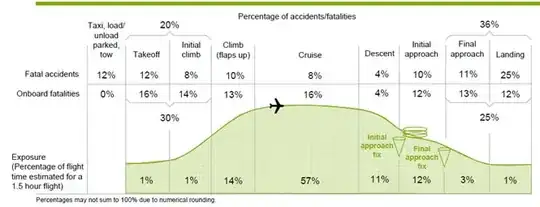I'm going to answer all your questions. No, theory, all numbers.
My point was that each time one flies on an airplane, it does not
increase the likelihood that he will die in a future airplane crash.
That is, each airplane flight is independent. Whether someone has
flown on 100 planes that year or just 1, both fliers still have a 1 in
10,000 chance of dying in their next plane crash.
This might be true as a standalone fact: independence of each crash occurrence. However, it's difficult to apply to a real life.
First, he probably meant to compare a frequent flyer vs. occasional flyer. If I fly a plane a couple of times a year to go to vacation, and his work involves weekly travel across the country, you must agree that he has a higher a chance of dying in a plane crash in the next year. We're not talking about one single flight, it's a lifestyle argument, or sample size in statistics.
Second, he's probably signed up to a frequent flyer program, which means that he always flies the same airline. Hence, the probability of a plane crash is probably more correlated in his case than in mine. So, the independence assumptions that you made is much weaker than it sounded first.
So, your friend is probably right.
Another point I made: say your destination is 4 hours away. If you
take a direct flight, you will be in the air, at risk of being in a
crash, for 4 hours. Now say you take 4 different connecting flights,
each flight about an hour long. In this scenario you will still be in
the air for roughly 4 hours. Thus, whether you take the direct flight
or save some money and take connecting flights, the amount of time you
spend at risk is roughly equal.
In 4 flights your cruising time is roughly the same as in 1 long flight, but you have 4 times more take-offs and descents. According to this web site, cruising is responsible for only 16% of fatalities. This graph shows the stats. You'll have more chance of dying in 4 short flights than in 1 long.

My final point was that shorter flights have a lower rate of crashes.
I just pulled that one out of nowhere. I've done zero research and
have zero data to back that up but...it seems logical.
This is probably not true. The shorter flights are more likely to be commuter flights, and these definitely have higher rates of fatalities according to this paper:
Throughout the period 1977–1994, scheduled commuter flights had far
higher crash rates than major airlines
Here, you can find some stats too. Look at the table "Which type of flying is safer" rows with Part 135 vs. 121.
If you're taking shorter flights with major airlines (which is less likely), there's still an argument on per mile basis. Per mile, the shorter flight must have higher fatality because, as I showed earlier, because you need to takeoff and land more times per mile, and these phases are the most dangerous in terms of fatalities.
UPDATE:
@AE question on what is not onboard fatalities. See this Boeing presentation with a ton of interesting data on airline crashes, where the airline accident is defined on p.3 as:
Airplane Accident: An occurrence associated with the operation of an
airplane that takes place between the time any person boards the
airplane with the intention of flight and such time as all such
persons have disembarked
then the external fatalities are defined on p.4 as:
External fatalities include on-ground fatalities as well as fatalities
on other aircraft involved.
The onboard means that death occurred to a passenger while he/she was onboard, see also CDC's reporting guideline here.
